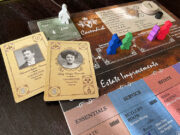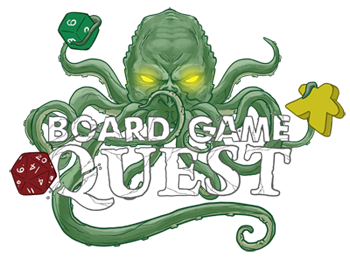 I remember wanting to be a pilot when I was a kid. It’s a pretty popular childhood dream—the image of flying through the air is inherently thrilling, plus you get as many of those little metal wings as you want. Imagine my dismay, then, when a friend of mine (who was training to be a pilot) let me in on a secret: flying is actually really hard.
I remember wanting to be a pilot when I was a kid. It’s a pretty popular childhood dream—the image of flying through the air is inherently thrilling, plus you get as many of those little metal wings as you want. Imagine my dismay, then, when a friend of mine (who was training to be a pilot) let me in on a secret: flying is actually really hard.
Well, that pretty much ended that dream then and there. Luckily, now I have a way to live out my dreams through the medium of board games! Sky Team has it all–engines? Check. Wings? Check. Capricious randomness and limited communication between co-pilots? Check!
…Okay, so it’s not exactly like flying a real plane, but I’ll just have to make do.
Sky Team is a cooperative dice game for exactly 2 players. It plays in about 15 minutes.
Gameplay Overview:
One player in Sky Team controls the pilot (in blue), and the other controls the co-pilot (in orange). Each round, both players roll their dice behind their player screens and alternate turns placing one die on spaces on the Control Panel until all dice have been placed.
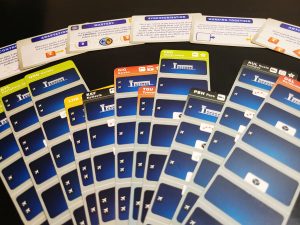
Each player must contribute a die to the Engines and Axis each round, which determines the plane’s speed and tilt; other spaces in the Control Panel are optional but still need to be activated at some point to successfully reach your destination. The Landing Gear and Flaps, for example, must be activated in a specific order with specific dice in order to deploy, and must be deployed before the plane lands. Similarly, the Radio must be activated at some points to clear away upcoming traffic, and the Brakes can be activated to make the landing process easier.
Every space is locked to a specific player; for example, only the pilot can activate the Landing Gear, and only the co-pilot can activate the Flaps. The only exception is the Concentration spaces, which can be activated by either player to earn dice mitigation for future rounds.
There are a lot of things that can go wrong. If the plane over- or under-shoots the airport, or comes in at too sharp an angle, or collides with another plane, or doesn’t have its landing gear and flaps deployed in time, or comes into the airport too fast, players lose the game. If, however, players manage to juggle all these plates with perfect timing, they successfully land the plane and can take a well-earned sigh of relief.
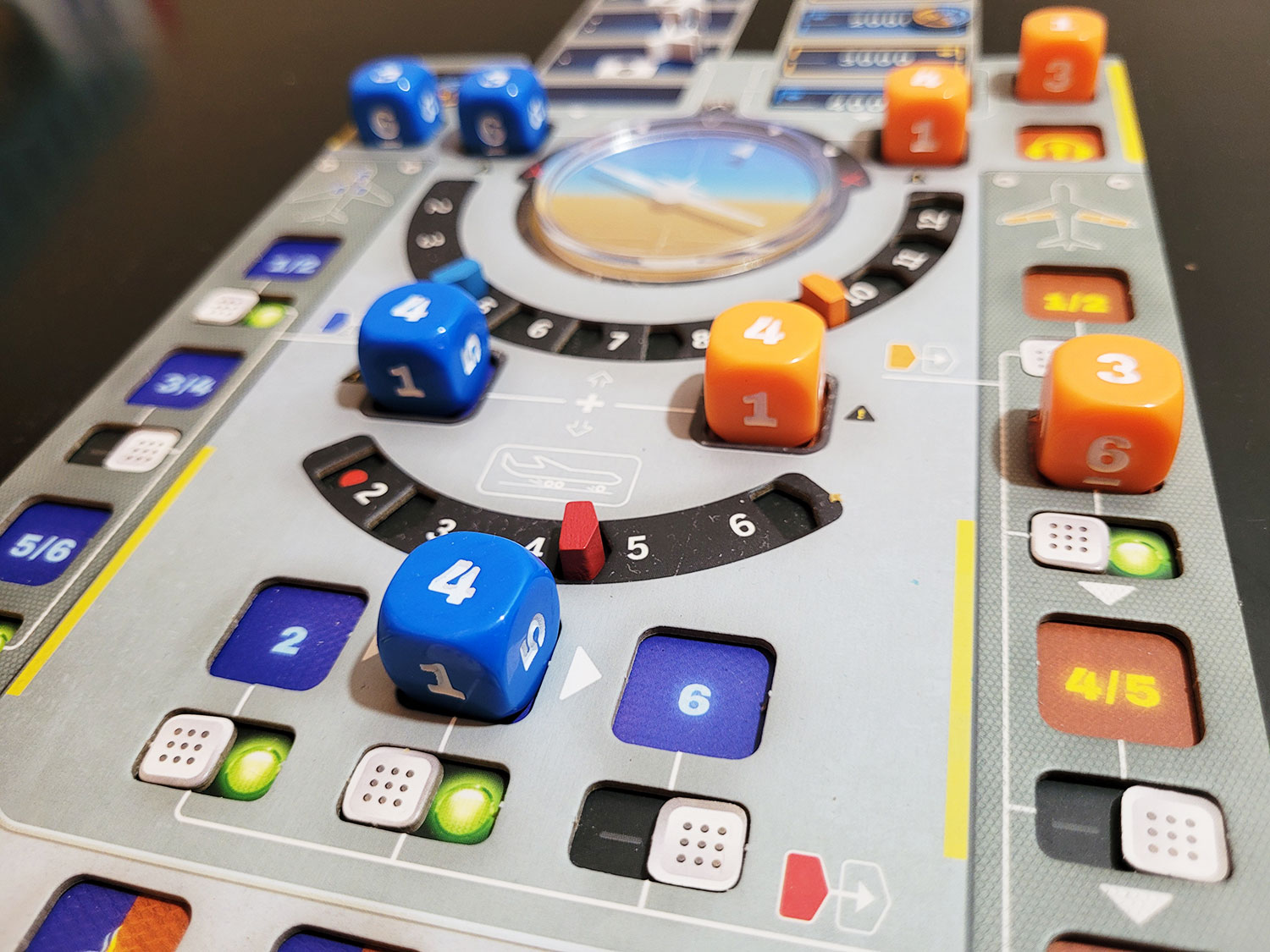
Game Experience:
Sky Team is much more complicated to explain than it is to play. The various rules are easy to internalize, and the graphic design of the Control Panel is quite intuitive—the player screens even have a rules reminder printed on the inside. The game takes pains to be as frictionless as possible.
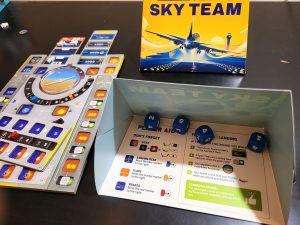
In fact, “frictionless” is a fitting word for the entire game. The choices on offer here aren’t deep, but that doesn’t mean they’re easy. Sometimes the dice roll exactly how you need them, but more often than not you have to let some fires burn so you can put out others. There are so many different ways to lose, and so many things to get right in order to win.
Of course, you can’t forget the other player. One teeny, tiny little rule I forgot to mention is that, once you roll dice for the round, players cannot speak. The only communication allowed is the meaning-laden placement of a die. This one rule alchemizes a fairly dry dice puzzle into a tense knot of risk-taking and double-guessing. Both players are pushed to deal with different crises, and the contemplative back and forth arising from this creates a dynamic texture from round to round.
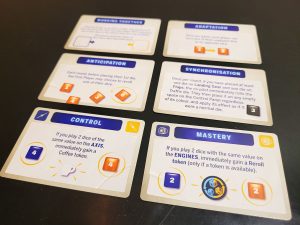
Admittedly, the base game of Sky Team is not actually that tense–players can muddle through without too much difficulty after a couple of games. Lucky, then, that the game includes a truckload of more involved scenarios. Each scenario uses one or more included mini-expansions that complicate the decision space, and as they increase in difficulty, players are further rewarded for successful cooperation. Each of these modules are fun and interacts in fun ways, which makes Sky Team a game that grows alongside its players.
However, as fun as Sky Team is, it only excels when you play it repeatedly with the same partner. The increasing tension that comes from silent cooperation builds camaraderie in a way you can’t replicate with just one or two exploratory games. It makes Sky Team amazing as a couple’s game, but less enticing as something to show to new people.
Also, even though teamwork and smart tactical play are rewarded, harder scenarios tend to hinge more on the luck of the dice. I never felt like my decisions were meaningless, but I definitely ran into games that felt unwinnable because of the dice. The game is short enough that it doesn’t ruin the experience, but it is a slight blemish on an otherwise squeaky-clean design.
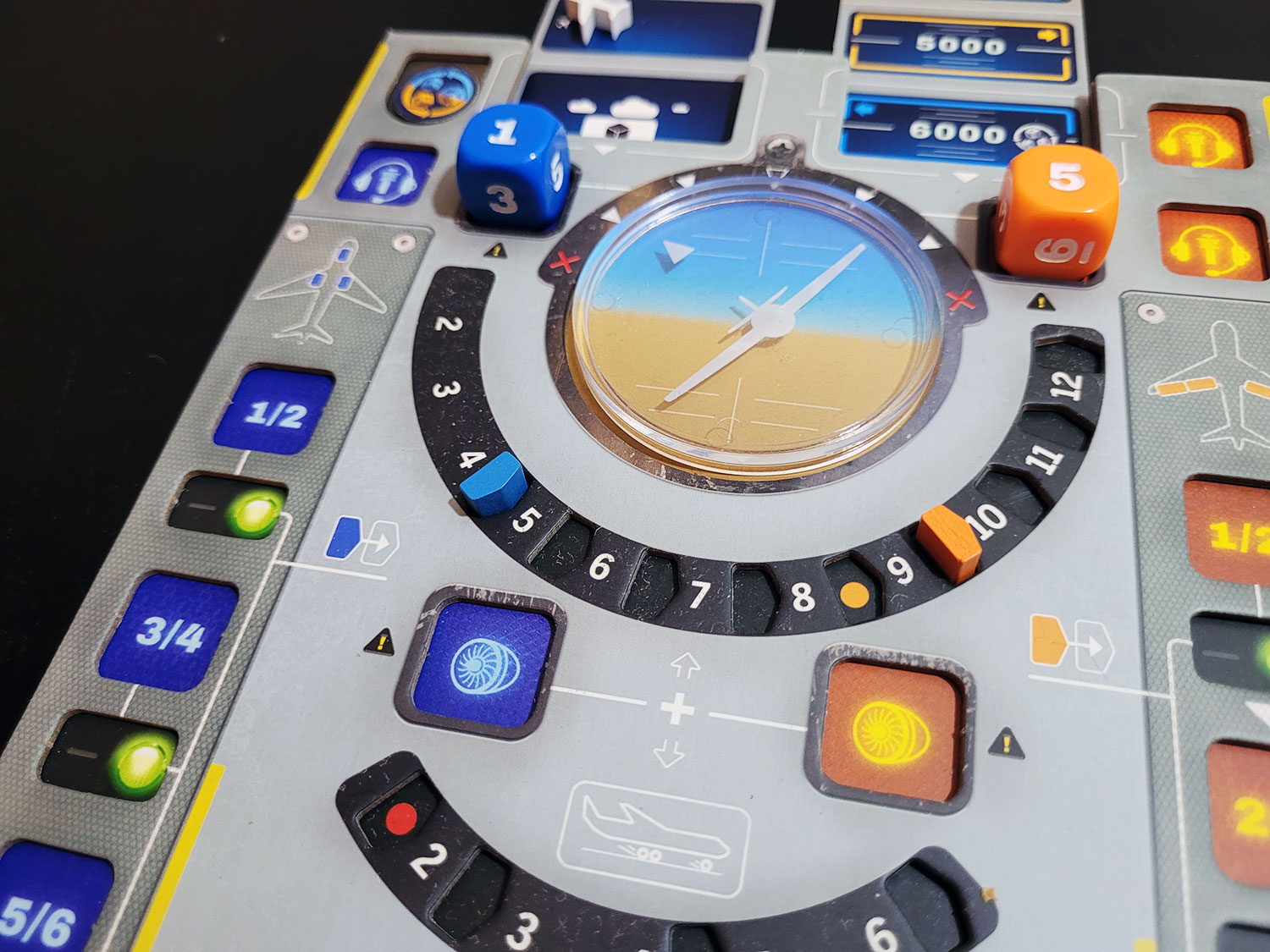
Final Thoughts:
Sky Team has become one of my go-to weeknight games. It’s lightning-fast to set up and play but has enough crunch and tension to feel like more than just a time-waster. The different scenarios also make it exciting to pull out repeatedly, watching my partners’ and my skills grow along with the game’s difficulty. It’s maybe a little too slight to become an all-time favorite, but as a bite-sized bit of fun, Sky Team is hard to beat.
Final Score: 4 Stars – A quick, popcorn thriller of a game that rewards cooperation and repeat plays.
 Hits:
Hits:
• Easy to learn, set up, and play
• Functional and user-friendly production
• Scenarios add a ton of variety
• Silent communication rewards repeat plays
Misses:
• Not ideal for showing off to new people
• Dice luck more pronounced at higher difficulties



